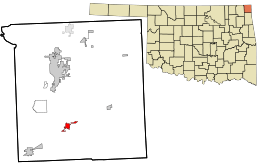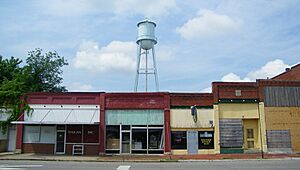Fairland, Oklahoma facts for kids
Quick facts for kids
Fairland, Oklahoma
|
|
|---|---|

Location within Ottawa County and the state of Oklahoma
|
|
| Country | United States |
| State | Oklahoma |
| County | Ottawa |
| Area | |
| • Total | 1.12 sq mi (2.90 km2) |
| • Land | 1.12 sq mi (2.90 km2) |
| • Water | 0.00 sq mi (0.00 km2) |
| Elevation | 840 ft (260 m) |
| Population
(2020)
|
|
| • Total | 1,106 |
| • Density | 987.50/sq mi (381.44/km2) |
| Time zone | UTC-6 (Central (CST)) |
| • Summer (DST) | UTC-5 (CDT) |
| ZIP code |
74343
|
| Area code(s) | 539/918 |
| FIPS code | 40-24900 |
| GNIS feature ID | 2412614 |
Fairland is a small town located in Ottawa County, Oklahoma, United States. In 2020, about 1,106 people lived there. This town is part of the historic Cherokee Nation.
Contents
History of Fairland
Fairland started when the St. Louis and San Francisco Railway (also known as Frisco) built train tracks through the area in 1871. The town was first about 225 acres big. Some businesses and homes moved there from a nearby area called Prairie Springs.
By the time Oklahoma became a state, Fairland was a busy farming community. In 1912, another railway, the Missouri, Oklahoma and Gulf Railway (later called KO&G), built tracks through Fairland. These new tracks crossed the older Frisco line.
Farming was the main way people made a living in Fairland until after World War II. In 1945, a big company called B. F. Goodrich opened a tire factory nearby. This factory became very important for Fairland's economy. Around 1950, the town started a volunteer fire department and built a sewer system. The Fairland School district also grew, taking in several smaller school areas. However, the KO&G railway stopped using its tracks around the same time.
The Goodrich factory closed in 1985. This was a big loss for Fairland. But new communities started to grow around Grand Lake O' the Cherokees. This helped the town's economy recover.
Geography of Fairland
Fairland covers about 1.12 square miles (2.90 square kilometers) of land. There is no water area within the town limits. The town is on a small hill. This hill is where three creeks begin: Hudson Creek, Ogeechee Creek, and Horse Creek. All these creeks eventually flow into the Neosho River.
Fairland's Population Over Time
| Historical population | |||
|---|---|---|---|
| Census | Pop. | %± | |
| 1900 | 499 | — | |
| 1910 | 569 | 14.0% | |
| 1920 | 818 | 43.8% | |
| 1930 | 679 | −17.0% | |
| 1940 | 786 | 15.8% | |
| 1950 | 699 | −11.1% | |
| 1960 | 646 | −7.6% | |
| 1970 | 814 | 26.0% | |
| 1980 | 1,073 | 31.8% | |
| 1990 | 916 | −14.6% | |
| 2000 | 1,025 | 11.9% | |
| 2010 | 1,057 | 3.1% | |
| 2020 | 1,106 | 4.6% | |
| U.S. Decennial Census | |||
In 2000, there were 1,025 people living in Fairland. These people lived in 415 households. About 292 of these households were families. The town had about 1,109 people per square mile.
Most people in Fairland were White (71.80%). About 20.39% were Native American. A small number of people were from other backgrounds.
In 2000, about 24.2% of the people were under 18 years old. About 22.0% were 65 years or older. The average age in Fairland was 39 years. For every 100 females, there were about 86 males.
The average income for a household in Fairland was about $27,240 per year. For families, the average income was about $28,885. Some families and individuals in Fairland lived below the poverty line.
Famous People from Fairland
- J. R. Conrad: He was a football player in the National Football League for teams like the New England Patriots and New York Jets.
- Lloyd Kiva New: He was a famous fashion designer. He also helped start the Institute of American Indian Arts. He was born in Fairland in 1916.
See also
 In Spanish: Fairland (Oklahoma) para niños
In Spanish: Fairland (Oklahoma) para niños


